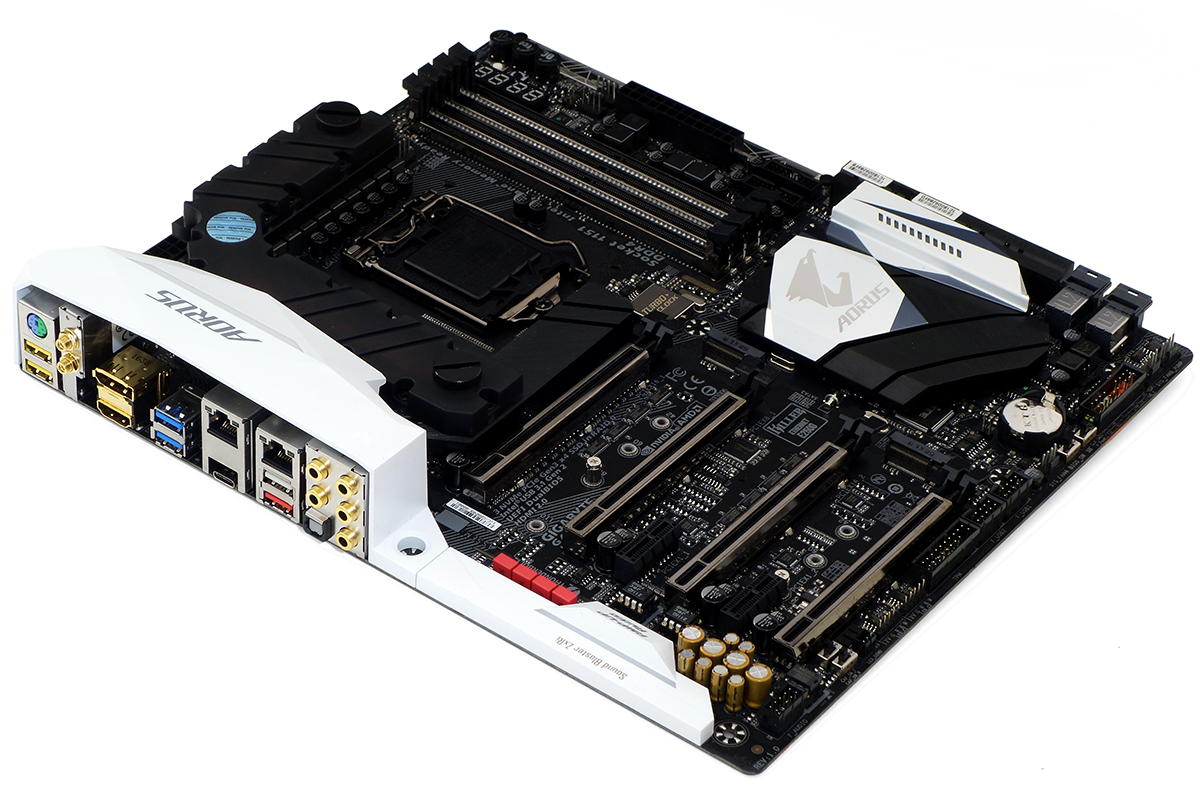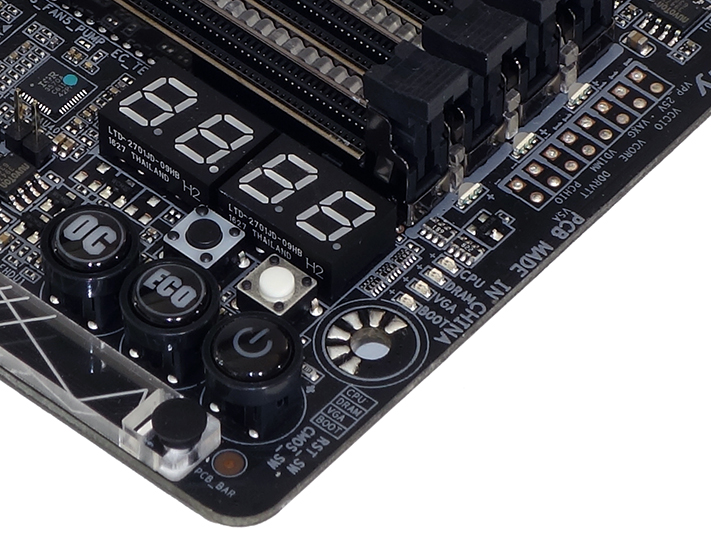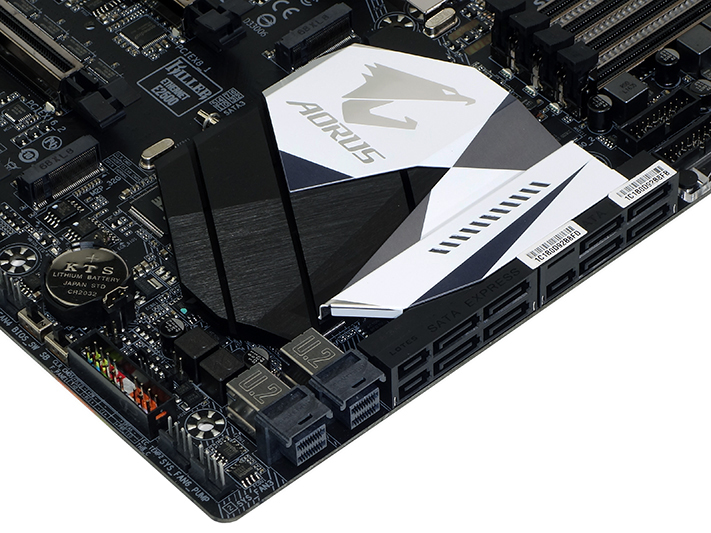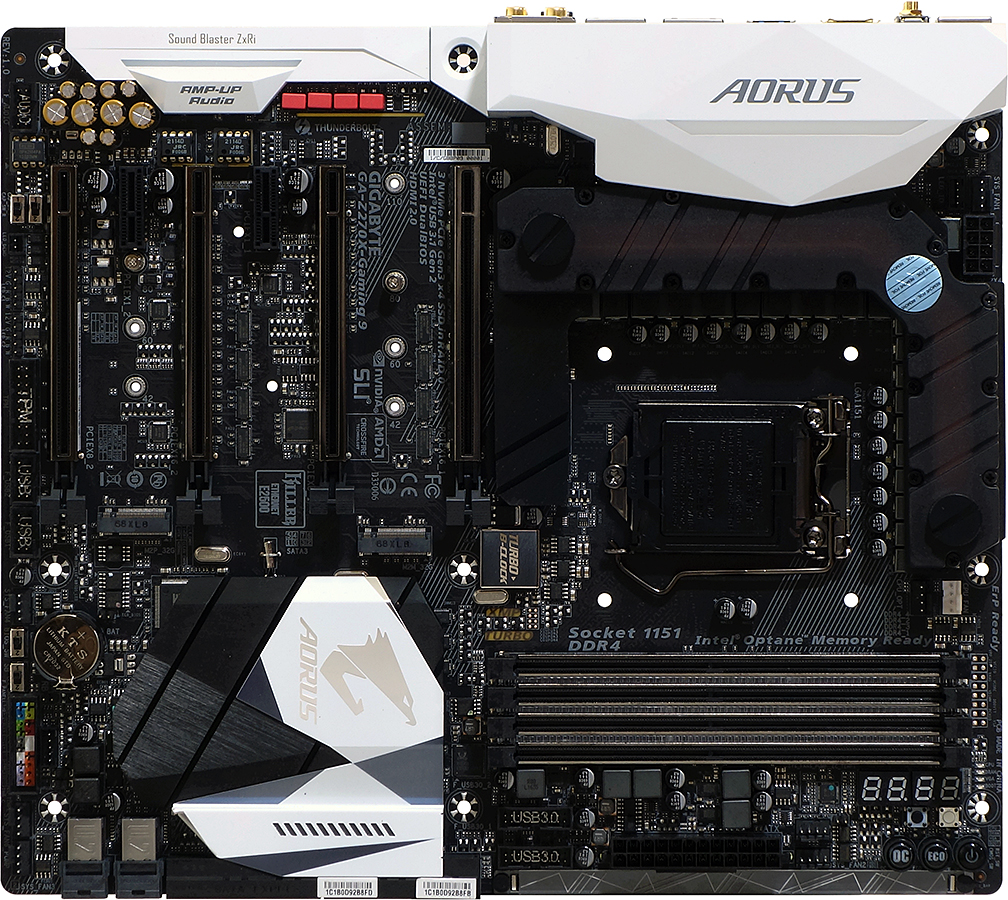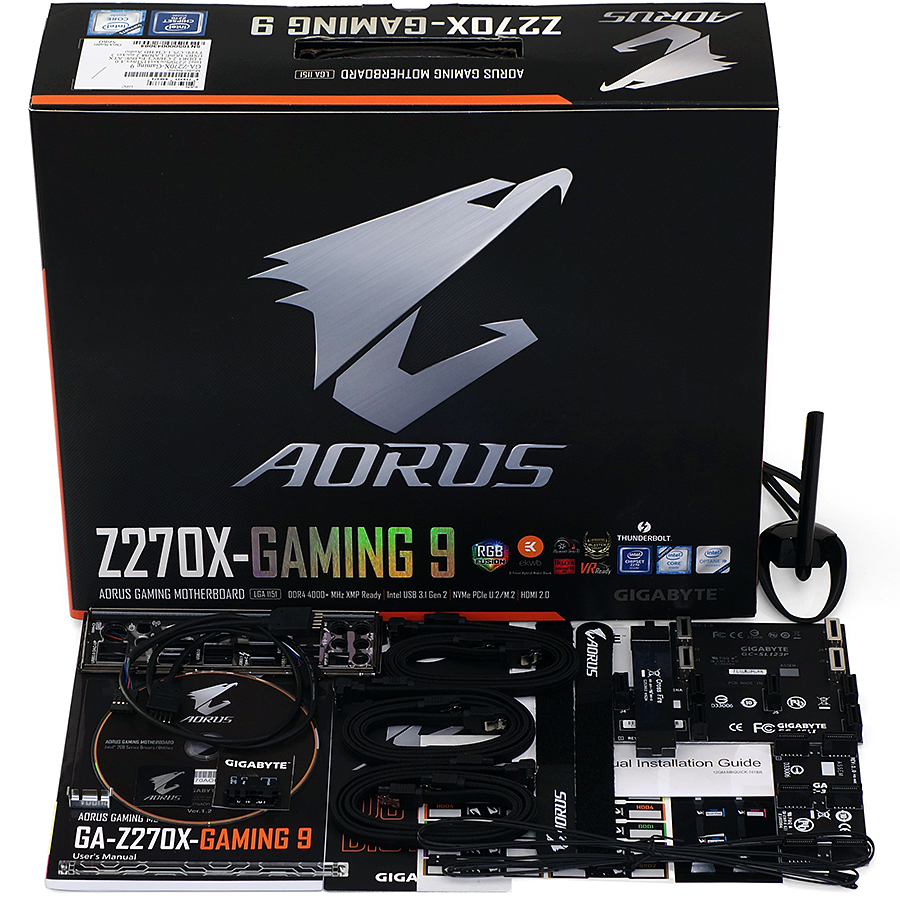Early Verdict
The Aorus Z270X-Gaming 9 pushes Intel’s latest mainstream platform beyond its basic limits of connectivity, appealing to ultimate system building fanatics as well as component reviewers.
Pros
- +
3- and 4-way SLI
- +
Dual Ethernet and 802.11ac Wi-Fi
- +
Enthusiast-class ZxRi audio with three high-end, upgradeable Op-Amps
- +
Highest-yet two-DIMM DRAM O/C
- +
Great layout
- +
No major connector conflicts
- +
8 high-capacity fan outputs with auto detection and manual PWM/Voltage selection
- +
EK “hybrid” chipset water block equally effective with cross-draft CPU coolers
Cons
- -
Price
- -
Minor performance impact for additional onboard components
- -
Minor energy penalty for additional onboard components
- -
Port resource sharing in spite of additional switches
- -
PCB is slightly oversized ATX
Why you can trust Tom's Hardware
Introducing The Aorus Z270X-Gaming 9
The Triple Quad Miracle?
There isn’t really anything astounding about a high-end motherboard, since it’s technically possible to continue adding features until you run out of ideas, rather than space. The ATX specification is large enough to throw just about any single CPU configuration into, and manufacturers are able to either spread out beyond the standard depth or add more layers of circuits when too many traces are packed too closely together. Gigabyte opts for the former in its Aorus Z270X-Gaming 9, extending the front edge an extra 0.5” (12.6mm) beyond ATX spec to a final 10.375” (263.5mm) depth.
The extra space means that we’re not even witnessing a packaging miracle.
Designed to fit most ATX cases and requiring only the ATX-standard nine standoffs, the Aorus Z270X-Gaming 9 is still endowed by Gigabyte with the E-ATX label. This deviation is sure to cause arguments among builders, which is why I’ve brought back my previously-discussed ATX+ label. The + is not an official form factor but instead indicates that this board is larger than ATX, and that builders should actually read the dimensions. Since it’s far closer to ATX than to E-ATX, it’s more accurate to say that it’s oversized ATX rather than undersized E-ATX.
The Triple part (from our section heading above) comes from the three Killer Network controllers that are able to work together as a team, intelligently placing the most demanding apps (usually game packets) on the lowest latency connection and using packet prioritization to assure that they’re first to be processed. In a configuration dubbed Killer DoubleShot-X3 Pro, the controllers include two Killer E2500 Gigabit Ethernet and one Killer 1535 802.11ac, all connected via PCIe. Other rear-panel connections include Thunderbolt 3 over Type-C, USB 3.1 over the same connector, USB 3.1 Type A, five USB 3.0 (aka USB 3.1 Gen1), DisplayPort, HDMI, Digital Optical audio, analog audio, and PS/2 serial.
Audio is provided by Creative’s Sound Blaster ZxRi chip, fed through three upgradable Op-Amps (OPA2134 front, NJM2114 left and right rear), using both Nichicon and WIMA capacitors. A pair of gain switches select 2.5x or 6x for front-panel and rear-panel headphones, and the circuit is Sound Blaster certified by Creative to produce at least a 120:1 decibel signal-to-noise ratio.
Opposite the audio section is the overclocking section, with a set of voltage detection points along the top edge, and a set of buttons along the front edge. The nondescript buttons are CLR_CMOS and Reset, and two digital panels display debug codes and programmable status readings such as CPU temperature. Another set of LEDs indicate initiation of the CPU, DRAM, graphics, and boot process. Also visible in the photo is one of two 2-pin jacks for included thermal sensor leads.
The Z270X-Gaming 9 is packed with M.2 slots, two U.2 ports, and eight SATA ports. Six of those SATA ports are even paired up to a PCIe 3.0 lane for SATA-Express. While all of that connectivity sounds fantastic by Z270 standards, it’s important to remember that all of the bandwidth is shared over a four-lane interface to the CPU. Furthermore, these can’t be filled simultaneously, as the upper M.2 slot steals resources from SATA ports 3 and 4, while the lower M.2 slot shares its SATA interface with SATA port 0. The lower M.2 slot also shares two PCIe lanes with the upper U.2 connector, dropping both to x2 mode. And there’s no free lunch on the two SATA ports added via ASMedia’s ASM1061, since both of those ports share the controller’s single PCIe 2.0 x1 interface.
Get Tom's Hardware's best news and in-depth reviews, straight to your inbox.
Around the bottom corner from the U.2 ports, a pair of BIOS mode switches allow users to disable Gigabyte’s dreaded auto-reflash function and instead select manually between two firmware ROMs.
The Z270X-Gaming 9 uses a PEX8747 to repeat the CPU’s 16 PCIe 3.0 lanes to two slots, after which a set of automatic lane switches allows the board to support four cards in x8 mode across its four PCIe x16-length slots. The controller’s “Multicast” function repeats data to two or four cards without running into any bandwidth sharing concerns, since all of the cards in an SLI or CrossFire array require identical data. The same can’t be said for the board’s second PCIe switch, the ASM1184e, which splits one PCIe 2.0 lane across both PCIe x1 slots.
Since most graphics cards have double-slot brackets, four-way SLI configurations typically require eight-slot cases. Two-way SLI is an easier fit, and users benefit from the added space it provides for graphics coolers up to 3.1” (78mm) thick.
Layout concerns are few and minor, such as the front-panel HD Audio header being located in the bottom-rear corner, just barely beyond reach of the cables of certain poorly-configured cases. Placing a graphics card in the lower slot will conceal several switches and headers, but the cables that go to those headers can usually be smashed flat without breaking the connection. Fan cables often have longer plastic ends, but the two affected headers are pushed all the way to the front of the bottom edge. And since the wires of USB 3.0 cables can’t be bent over, those headers are both located above all the expansion cards.
The EKWB water block that covers the CPU voltage regulator and PEX8747 multicast PCIe switch is also designed to work with air-based cross-draft CPU coolers, just in case you don’t have an open loop yet.
The Z270X-Gaming 9 includes a lighted I/O shield, two RGBW case-LED extension cables, an Aorus case badge, a G-Connect front-panel cable clip, HDMI and DisplayPort dust plugs, an alternative LED cover for the motherboard’s forward edge, six SATA cables with braided sleeves, two cable straps, a CrossFire bridge, SLI bridges in HB, 4-way, and 3-way configurations, a Wi-Fi antenna, two temperature monitor cables with thermistor tips, a variety of cable stickers, a “keep out” doorknob card, and a full set of printed documentation.
MORE: Best Motherboards
MORE: How To Choose A Motherboard
MORE: All Motherboard Content
Current page: Introducing The Aorus Z270X-Gaming 9
Next Page Aorus Z270X-Gaming 9 Software And Firmware-
sillynilly Mmmm not so sure here. Not much gain for double the price and SLI when Nvidia is moving away from it? I just don't get the point of this mobo. It has some cool features, but the number one thing listed - SLI - is kind of supported these days?Reply -
redgarl Motherboards are becoming so expensive. They cost the double of what they were costing 5 years ago. So many useless gadget are now offered out of the box that drive the price up. My personal limit was always 200$ and I am going to stick to it. Optimal OC doesn't worth 100$. Better upgrading the CPU at that price.Reply -
Eximo I went with the Gaming 5, it has more features than I need. A distinct lack of accessories in the box I suppose, but I really didn't need anything beyond the board itself. Still thought it was expensive. Might just be inflation though.Reply -
Crashman Reply
I'm not sure what you mean by "kind of supported", but this might have been an incomplete expression of a greater thought. And if you're thinking "Three way SLI has been phased out on the most-recent cards, and two-way SLI is supported without the extra components", then you're thinking like a responsible spender.19355338 said:Mmmm not so sure here. Not much gain for double the price and SLI when Nvidia is moving away from it? I just don't get the point of this mobo. It has some cool features, but the number one thing listed - SLI - is kind of supported these days?
It's the top LGA 1151 board for overclocking and testing various configurations, so it wins. If I had to pay for it, I would have likely chosen a lesser board.
-
turbotong So Poll - who actually upgrades their motherboard op amps? My motherboard came with the feature, but I don't ever plan to do so.Reply -
ttt_2017 I miss the old days when motherboards came without onboard sound ... Today Motherboards come with everything onboard that you almost never use the expansion slots ...Reply
What is the point of 7 slots when you never use all of them ? I think it is better to let us choose the sound card , the LAN card instead of forcing us to accept what the company put onboard when it comes to 7 slots motherboards (ATX)
The fun is gone all together.
IMO onboard components should be on mATX and ITX mobos , because it is hard to add cards .. but for ATX ? make them cheap and let us choose the other hardware parts please. much more better .
For Example , Creative Z cards used on this motherboard are good , but what If I want Asus Xonar high end card ? and still want this motherboard ? Why pay twice for audio chip ?
What if I want better Lan chip ? Wifi ? Etc ?
What is the point in buying a motherboard with 7 slots other than adding hardware of choice ?
What if I want a better USB3.1 chip ? instead of Asmedia I get Intel ?
we want High END motherboard (best OC , RGB leds , Best cooling) but Empty as well so we add the hardware we want as we wish. like the old times.
